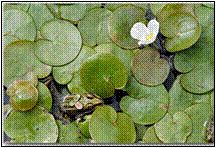|
"Your gateway to
understanding |
European Frog-Bit
click for full size
• Discovered in Oneida Lake in 2004
• Resembles a miniature water lily
• Leaves cover the water’s surface and can shade out native vegetation
European frog-bit is an Eurasian species imported to Ottawa, Canada in 1932 for cultivation. It was first discovered in eastern Oneida Lake at the mouth of Oneida Creek in 2004. By June 2005, frog-bit had appeared in the Oneida River, Big Bay, and in six marinas. This species can be further by entanglement on boats and trailers.
Frog-bit is a free-floating (roots are not anchored in the sediment) aquatic plant that resembles a tiny water lily. Its rounded, smooth, thick, leathery leaves rarely exceed two inches in diameter. The undersides of the leaves are spongy and purplish-red in color. Single flowers are about one-half inch across with three white petals and a yellow center. Roots are three to eight inches long and hang freely beneath the plant's floating leaves.
Frog-bit can form a dense floating canopy that restricts the availability of light and nutrients that nourish submerged native vegetation. It may also negatively impact fish by depleting dissolved oxygen levels. It prefers quiet, protected waters near the lake's shore and in marinas. Plants can reproduce either by sending out horizontal stems that produce daughter plants or by producing small buds that sink to the bottom in fall and float back up in spring to grow into new plants.
To learn more about European Frog-bit ...

